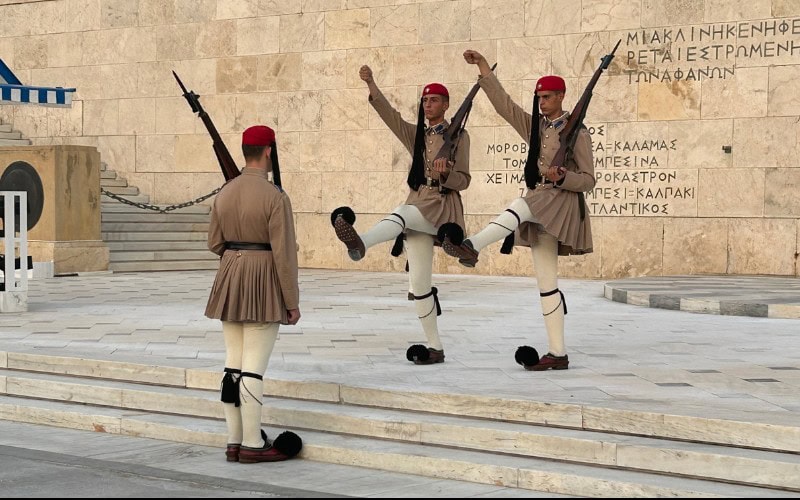How to Spend a Perfect Artsy Traveler Day in Athens
Artsy Traveler contains affiliate links for products and services I personally use and can happily recommend. As an Amazon Associate, I earn from qualifying purchases. Please read the Disclosure for more information. If you make a purchase through these links, at no additional cost to you, Artsy Traveler earns a small commission. Thank you!
In one day in Athens, you can easily see and enjoy a good taste of what this wonderful and historic city has to offer the Artsy Traveler.
For a perfect Artsy Traveler day in Athens, I suggest taking a walking tour, strolling around some of the lesser-visited archeological sites and visiting either the National Archeological Museum or the Acropolis Museum.
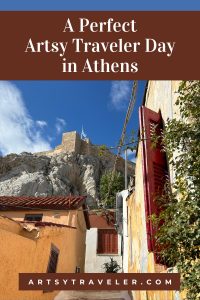
Later in the afternoon, stop at Syntagma (Constitution) Square to watch the Changing of the Guard, and then end your perfect Artsy Traveler day with an evening performance of folk dancing at the Dora Stratou Theatre, followed by dinner and a spot of souvenir shopping in the lively Plaka district.
What About the Acropolis?
I don’t include the Acropolis as part of a Perfect Artsy Traveler Day in Athens, not because it’s not worth visiting (it certainly is!), but because it’s likely already on your agenda. Visit the Acropolis in the late afternoon the day before your perfect day in Athens. It’s the star attraction, but once you’ve seen it, you can relax and explore all the other wonderful sites and experiences that Athens has to offer.
For my take on how to enjoy the Acropolis, check out Should You Make the Climb to the Acropolis in Athens.
Here’s how I suggest you spend your perfect Artsy Traveler day in Athens.
Orientation to Athens
Athens is a very large city, and you may at first be worried, as I was, that it will be too busy and crowded for comfort. You’ll likely be pleasantly surprised. The area of Athens that most interests visitors is compact and easy to navigate. You’ll find many pedestrianized streets, some leafy squares and gardens, and a general aura of calm.
While you may expect tooting horns and pollution, you’re more likely to experience laid-back and cheerful.
Here’s a map showing the locations mentioned in this post.
Morning on A Perfect Artsy Traveler Day in Athens
Start your perfect Artsy Traveler day with a walking tour. If you’re visiting during hot weather, the streets in the morning will be shadier and the air cooler. You can find plenty of walking tours in Athens; I recommend a GuruWalk.
Hidden Gems GuruWalk of Athens
On its website, GuruWalk claims that “the best free walking tour guides in the world are here.” The company provides access to an international community of pay-what-you-please walking tours. They call their guides “gurus” and describe them as “open, attentive, fun people with great knowledge of the city.”
I recommend the Hidden Gems tour of Athens with GuruWalk guide Anastasios, who enthusiastically shared his love of Greek history—and especially ancient Greek history—on a two-hour tour that took us up the slopes of the Acropolis.
Meeting the Hidden Gems Tour
You’ll meet the tour in a small park in front of the Monument of Lycicrates (#1 on the map) near the Diogenis restaurant in the Plaka area (#3), not far from my recommended accommodation at Karma Suites (#2). When I took the tour, I joined about twenty-five people from all over the world: Belgium, Spain, Italy, England, Lithuania, Brazil, Denmark, the US, and Julia and me from Canada.
The tour involved quite a bit of walking up steep stairs and along very narrow lanes. One of the first stops was the tiny neighborhood of Anafiotika, located under the northeastern side of the Acropolis Hill in the middle of historical Plaka.
Anafiotika
Our guide Anastasios informed the group that Anafiotika (#4) was built by workers who came from the Cyclades Islands (Santironi, Mykonos, Naxos, et al) to build Plaka in the early 19th century.
Here’s a view of one of the narrow, picturesque streets with the Acropolis looming above.
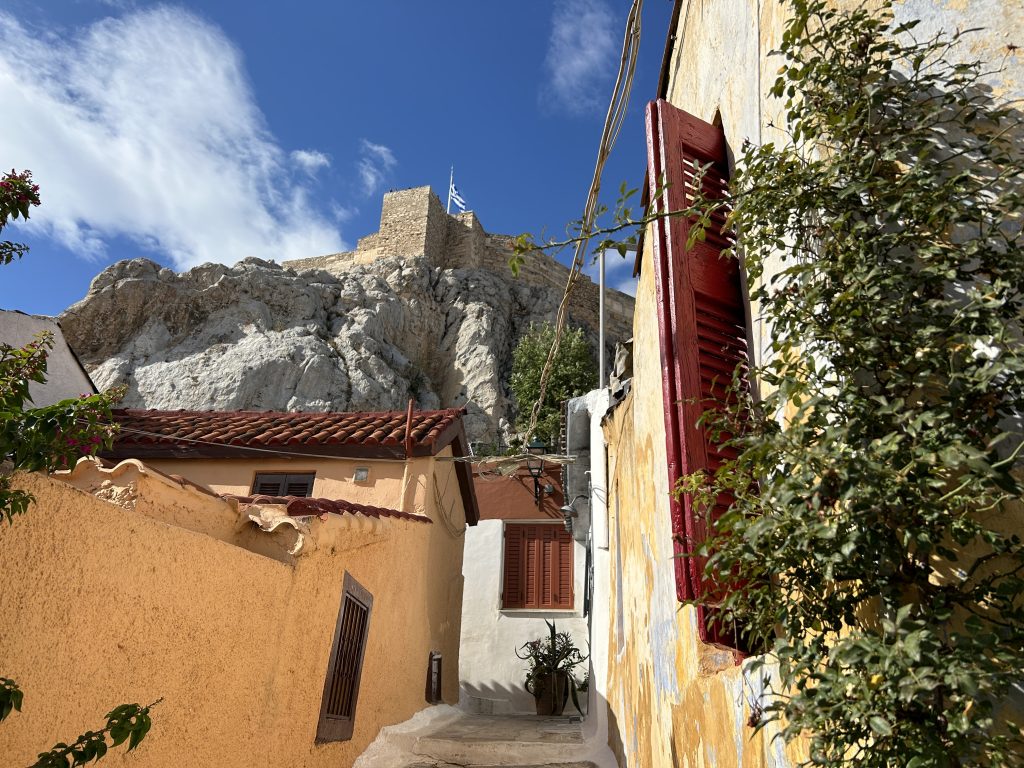
The workers built their homes in the island style—white-washed, thick-walled houses clustered around tiny lanes, some barely wide enough to fit a lumbering donkey. How they managed to get furniture into their houses in anyone’s guess, although Anastasios mentioned that most of the homes have been abandoned because the area was made part of the archeological site of the Acropolis. A few families still live there, but unofficially.
Progressing Around the Acropolis
Anastasios provided an excellent “Hidden Gems” tour of the area around the Acropolis. He stopped frequently at places with walls to perch on so participants could listen in comfort as he talked about history and philosophy, and shared tips about how to get the best out of our Athens visit.
You’ll find his historical stories–told with enthusiasm and pride–fascinating. He really knows his history and is obviously happy to share what he knows. You’ll learn just how much we owe to the ancient Greeks—theater, philosophy, architecture, democracy, mathematics, medicine—the list goes on and on.
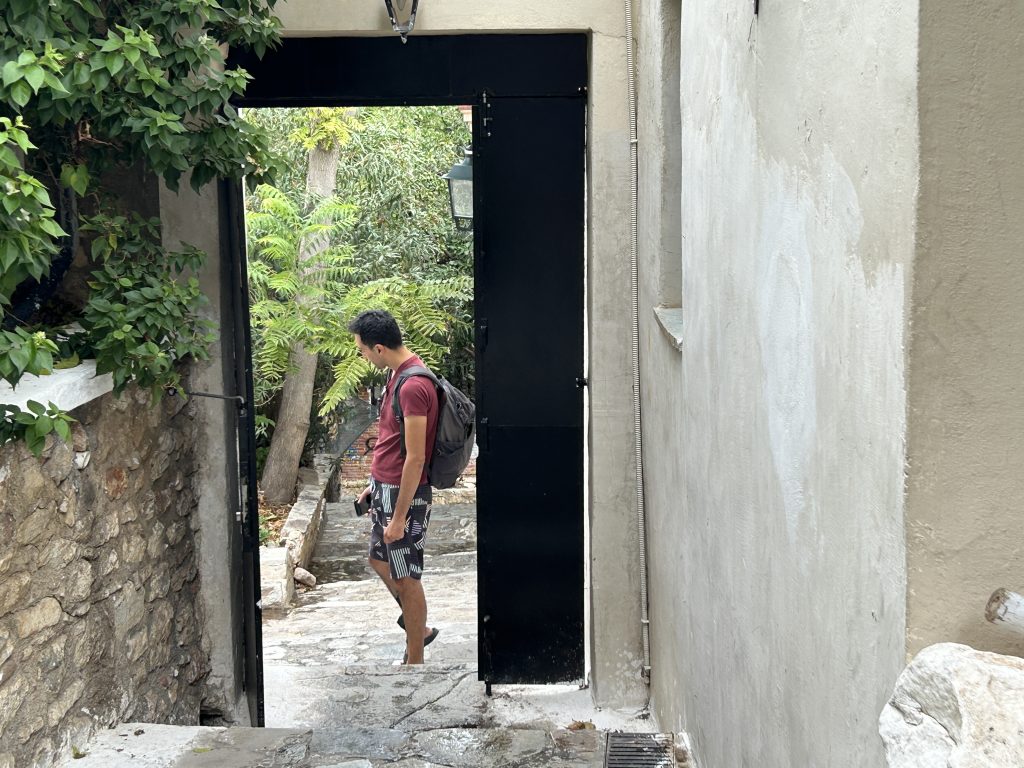
At the end of the tour, Anastasios directed participants to his GuruWalk page where he’d listed his recommendations for Athens, including the best places to view the sunset as well as good restaurants in the area.
If you’re visiting Athens, sign up for the Hidden Gems tour. You’ll learn a lot, see some places you’d never find on your own, and get a good work-out. Despite a lot of steep climbing, fortunately the pace is pleasingly sedate with frequent stops to sit and listen.
Exploring Athens
Agora & Archeological Sites on the Combo Ticket
Spend some of your perfect Artsy Traveler day in Athens checking out the Agora (#5) and other archeological sites. I suggest you purchase the combo ticket when you visit the Acropolis so that you can tour up to six more archeological sites.
The Agora is a large area littered with ruined bits of ancient Greece. It’s peaceful, uncrowded, and verdant, with plenty of scope for the imagination. It’s not much of a stretch to visualize ancient Greeks going about their business—buying, selling, eating, drinking, arguing, and loving, just like modern Greeks are still doing in the streets adjacent to the Agora.
Enjoying this post? Subscribe to Artsy Traveler to Receive Valuable Travel Tips and Your FREE Guide: 25 Must-Do Artsy Traveler Experiences in Europe for 2025

A highlight is the Temple of Hephaestus (#6), the god of blacksmiths. This very impressive temple takes pride of place on a slight rise and is highly photogenic—far more so than its big brother up on top of the Acropolis. The temple is scaffolding-free and in surprisingly good nick.
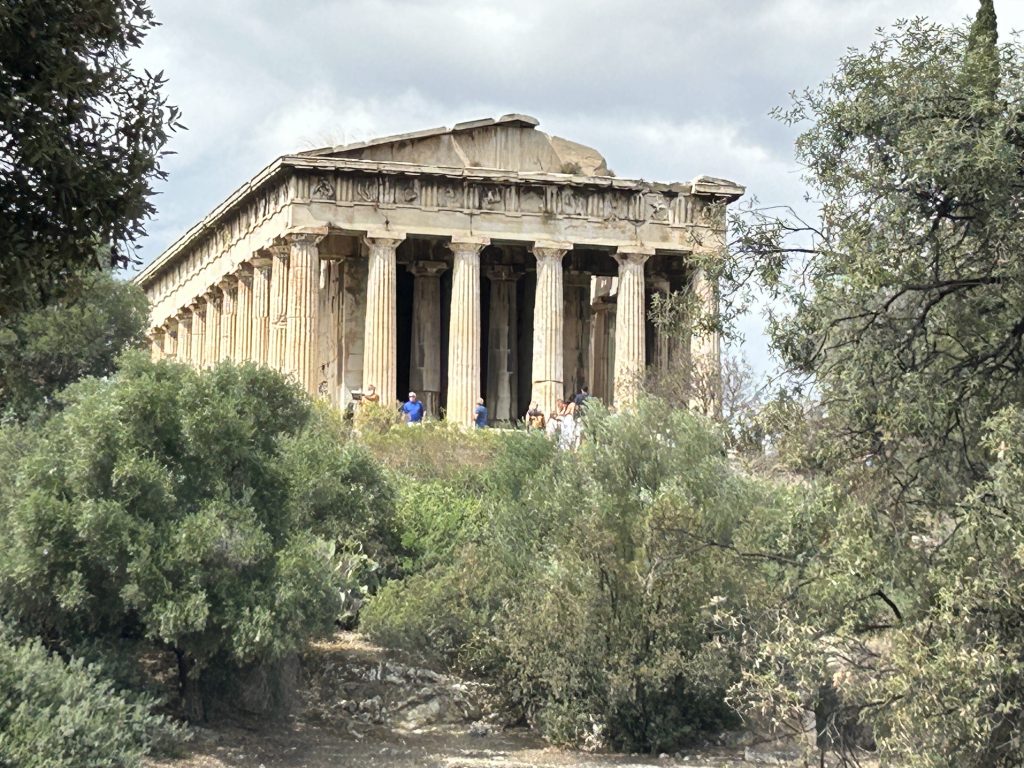
Lunch in Monastiraki
The chef who ran the cooking class that Julia and I took in Nafplio (see Explore Greek Cuisine in a Savor Nafplio Cooking Class) recommended we visit a famous deli in the Monastiraki district. I definitely recommend you check this place out for lunch. Called Ta Karamanlidika tou Fani (#7), it’s crowded, lively, and full of both tourists and locals.
And the food! We ordered and quickly devoured a meat and cheese board.
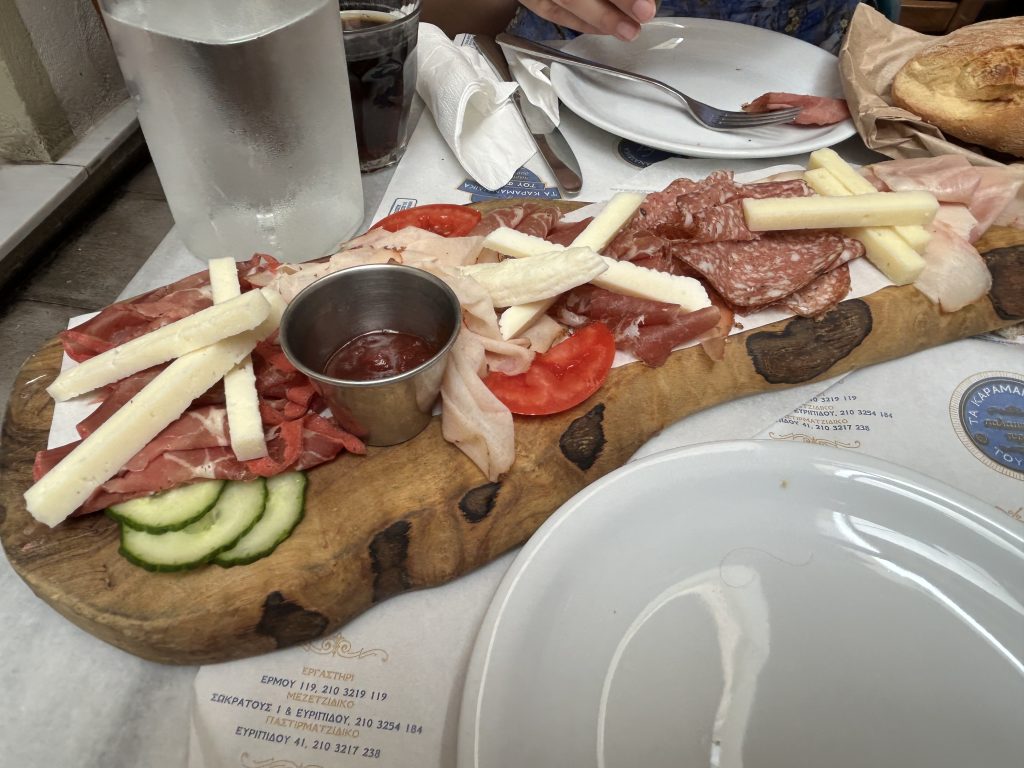
Although we arrived without a reservation, we were quickly seated in the back courtyard. Service was fast and the food delicious.
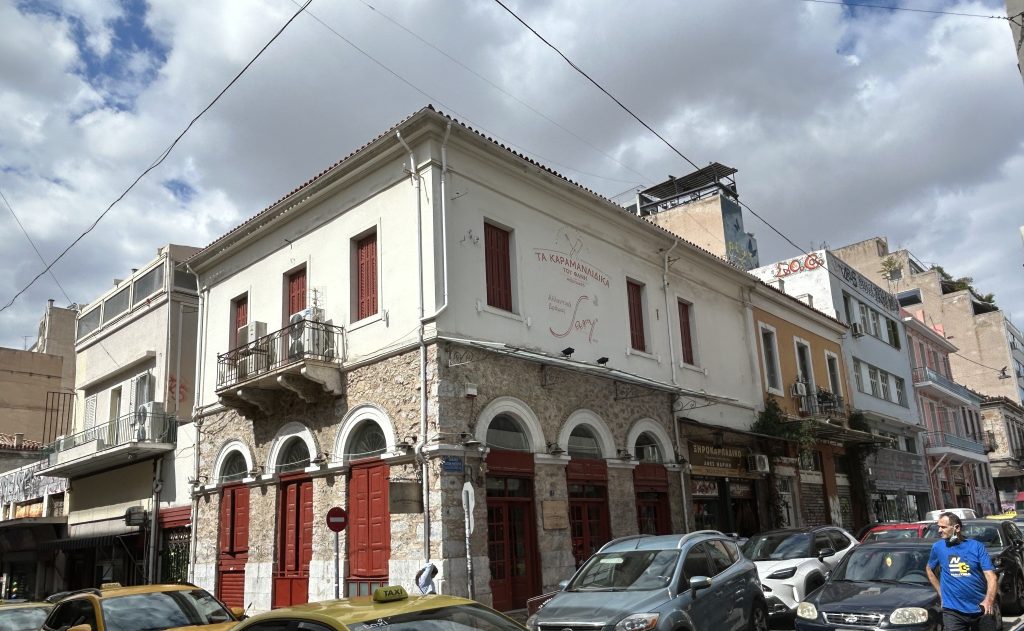
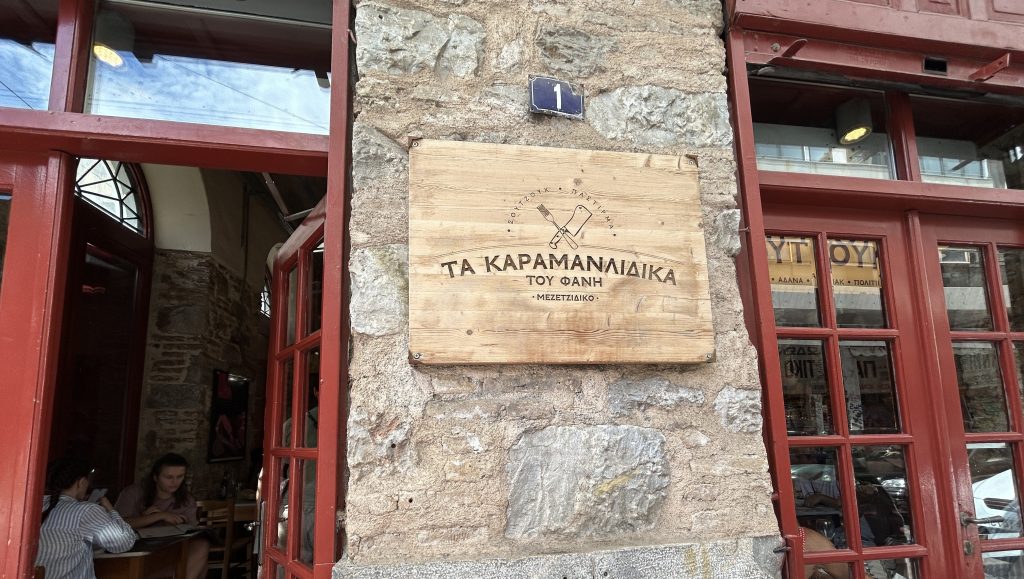
Shops in Monastiraki
This lively and very Greek-feeling area is full of interesting food shops. Take some time to wander the narrow streets and check out the many displays of meats, herbs, and other foods hanging from open doorways.
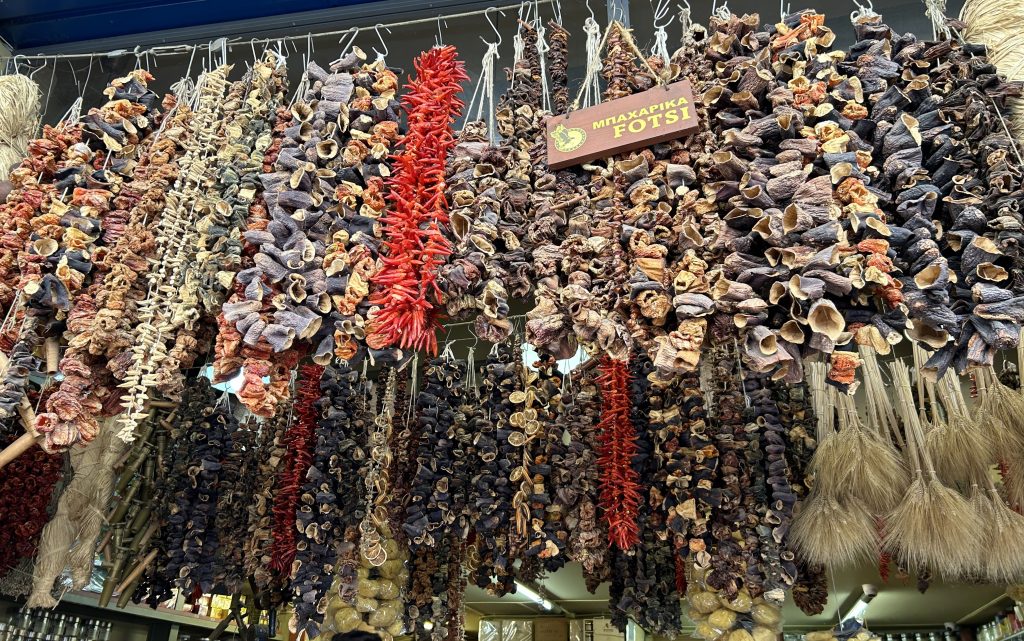

National Archeological Museum
Allocate at least two to three hours to tour the marvelous National Archeological Museum(#8) . You can get there via Uber (which is actually just a local taxi) or walk for about twenty minutes from Monastiraki.
While not as state-of-the-art and modern as the Acropolis Museum (#11), the National Archeological Museum is still an Athens must-see. It’s the largest archaeological museum in Greece and one of the world’s most important museums devoted to ancient Greek art.
Centuries of ancient Greek history, from the earliest inhabitants to the Romans, are displayed in several large rooms. Information about each exhibit is provided in both English and Greek so it’s easy to tour the museum and figure out what you’re looking at.
Here are some of the highlights.
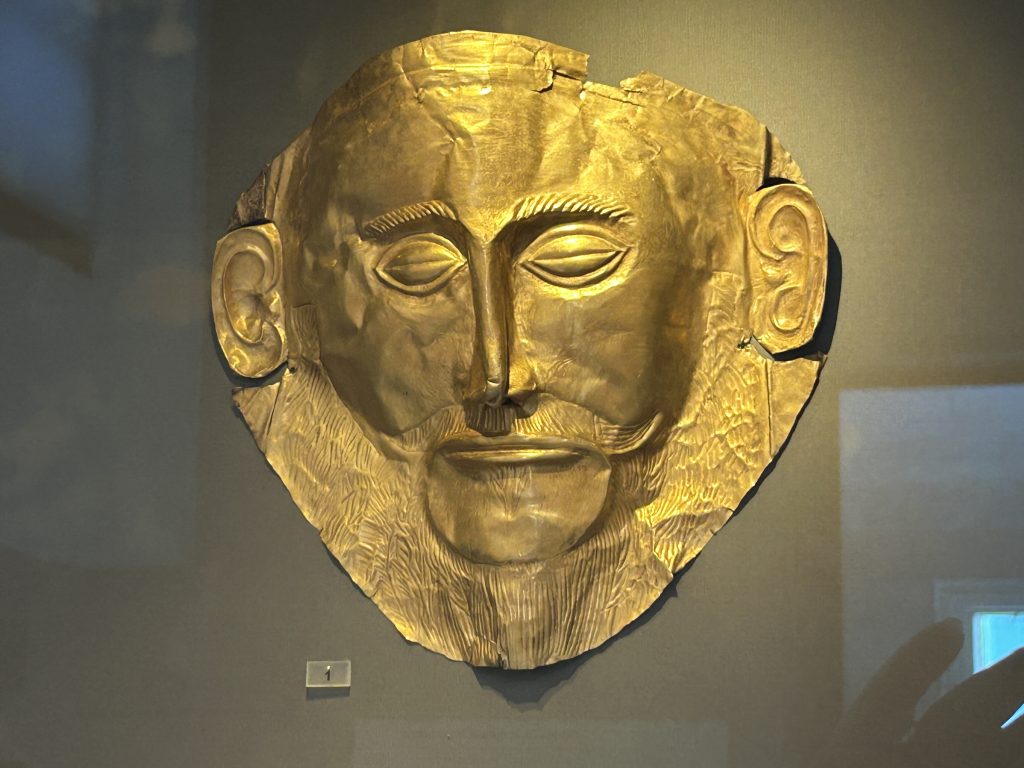
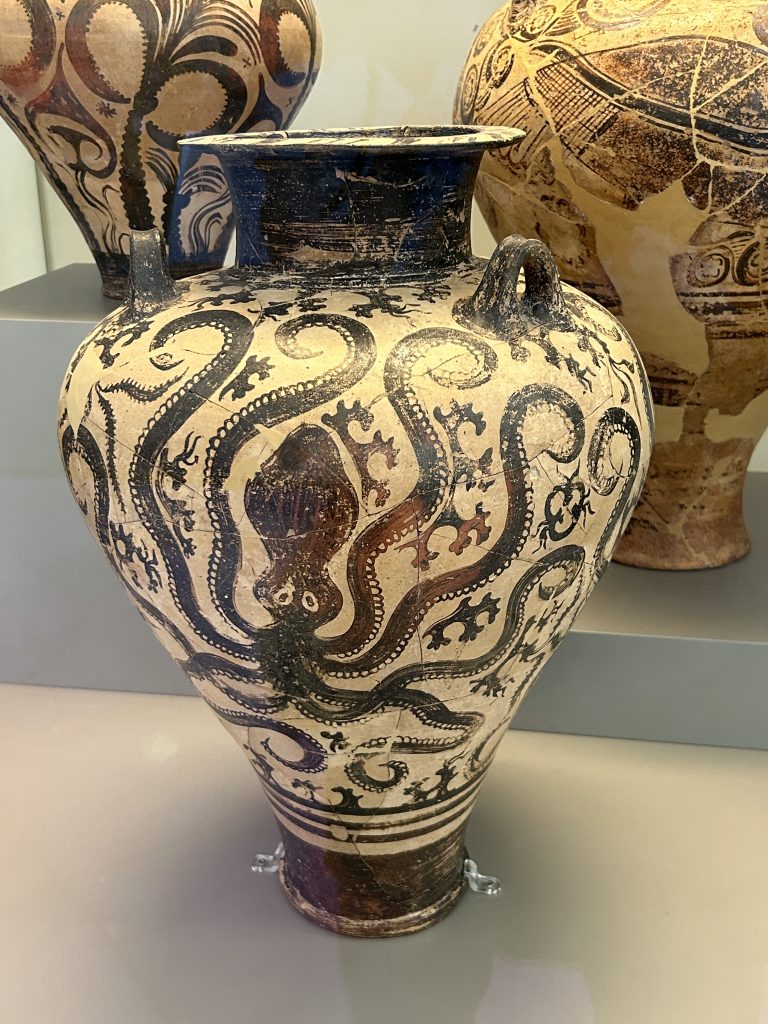
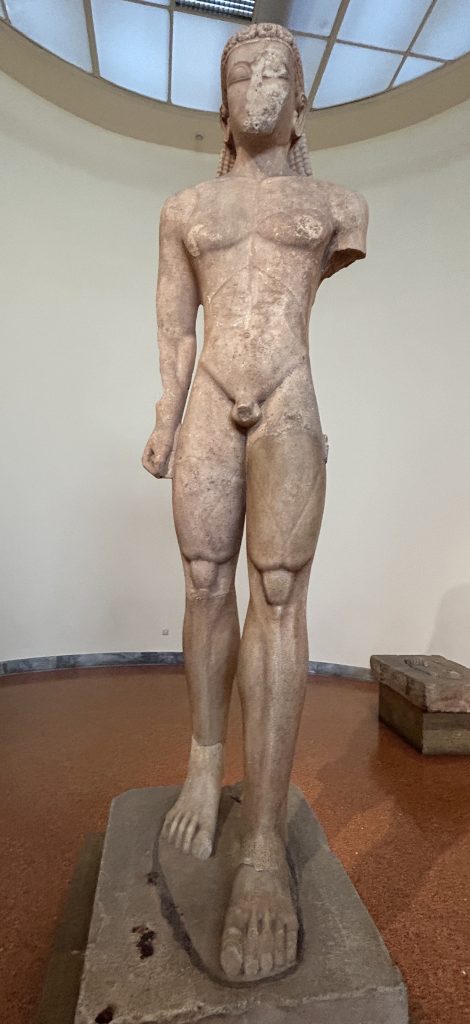
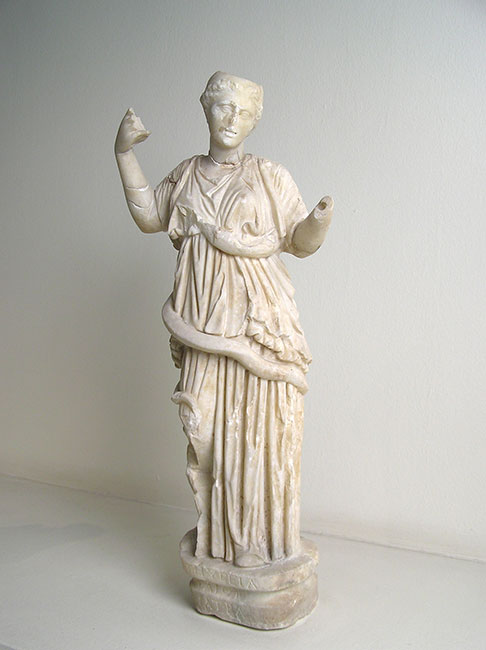
For a detailed overview about what to see at the National Archeological Museum, read my post: What To See at The National Archeological Museum in Athens.
Acropolis Museum
You’ll want to visit both the National Archeological Museum and the Acropolis Museum, but not on the same day. I love museums, but even I try to pace myself!
Visit the Acropolis Museum after you visit the Acropolis itself. If you’re in Athens on a Friday, start your visit to the Acropolis around 5 pm, and then descend and visit the museum, which is open until 10 pm.
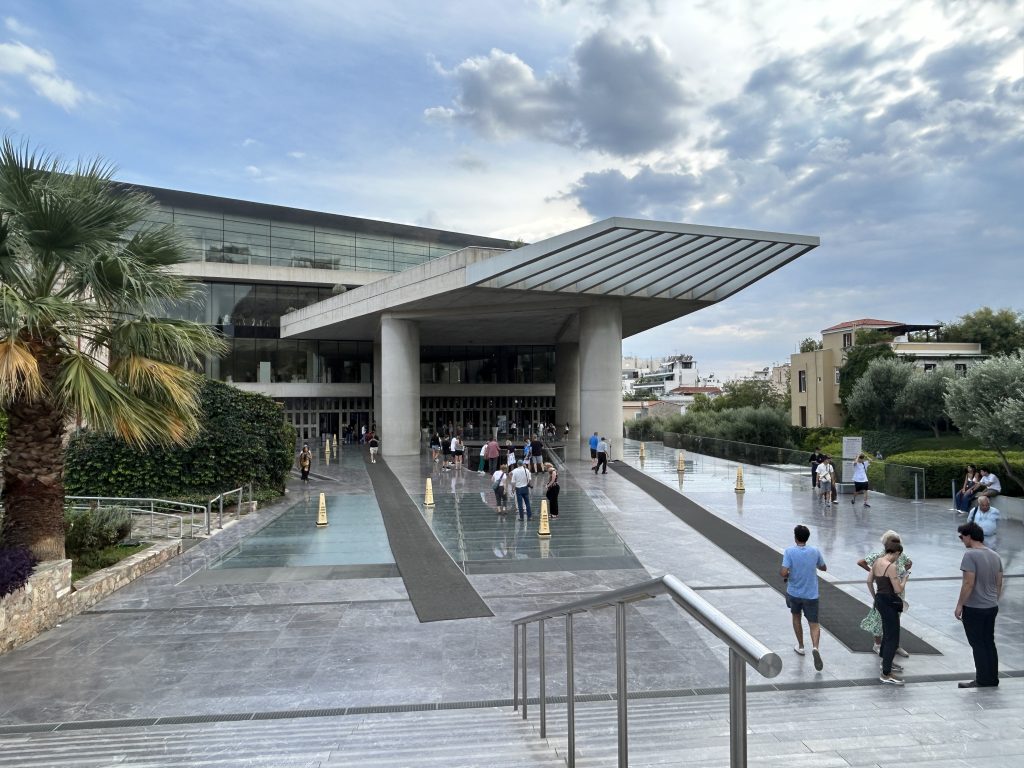
For more about the Acropolis Museum, check out my post Should You Make the Climb to the Acropolis of Athens?
Syntagma and the Changing of the Guard
After visiting the marvelous National Archeological Museum in Athens, catch another Uber for about five euros to Syntagma (#9), otherwise known as Constitution Square. This area is the heart of modern Athens and the location of the Hellenic Parliament. Your mission is to see the famed Changing of the Guard.
Every hour, the guards who stand in perfect stillness in front of the Parliament participate in a slow, graceful, and achingly beautiful Changing of the Guard ceremony. On Sundays at 11:00 am, a more elaborate ceremony takes place.
The sun was blazing across the façade of the parliament building when we arrived to find two young soldiers dressed in traditional uniform. Their composure and stamina was remarkable. I was relieved to see that they stood under small awnings which presumably gave them some protection from the sun.
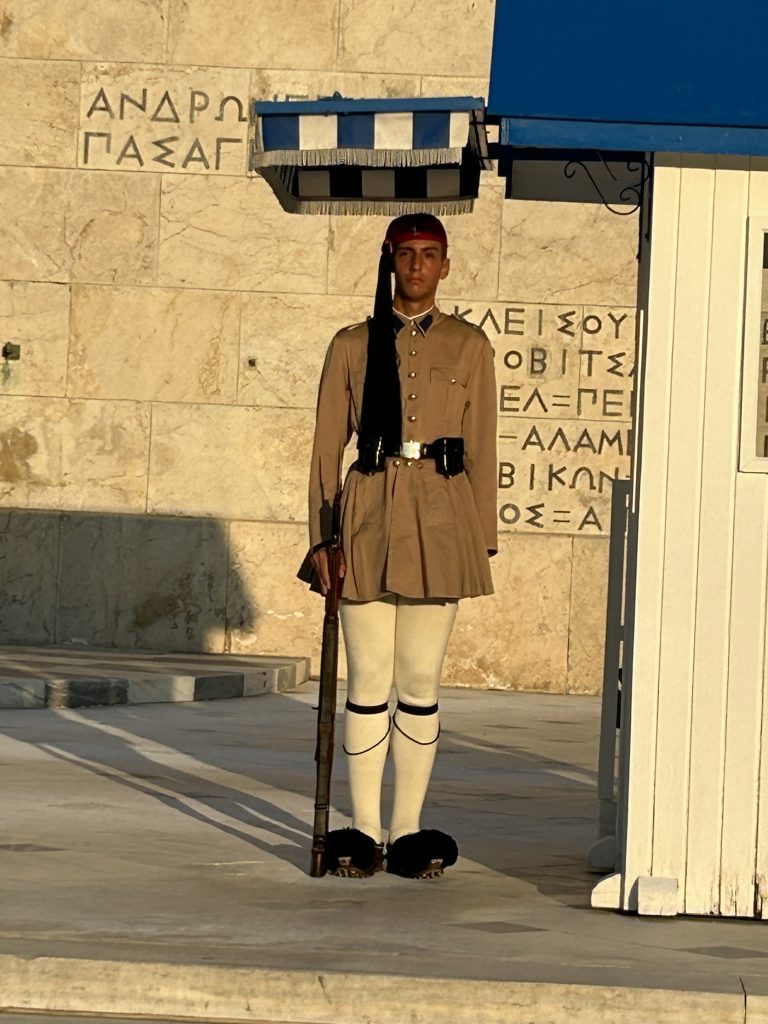
Who Are The Guards?
The guards are from the elite Evzones unit of the Hellenic Army, and their duty is to guard the Monument of the Unknown Soldier in front of the Hellenic Parliament and the Presidential Mansion. The monument is dedicated to Greek soldiers who were killed in war. The Evzones are symbols of bravery and courage for the Greek people.
Uniform of the Guards
The traditional uniform worn by the guards fascinated me. The day we visited, they wore a light tan jacket, but I’ve seen pictures of them wearing navy blue jackets.
The uniform consists of the farion, the Evzone’s fez, that is made from red baize and features a black silk tuft and the Greek coat of arms; a white shirt with loose sleeves; a handmade waistcoat adorned with several delicate shapes; the fustanella, which is the Greek kilt consisting of 400 folds, each representing one year of the 400-year Ottoman occupation; two socks on each leg; a leather belt that holds the socks; the tsarouchia, which are the traditional red leather shoes (each weighing three kilos!) with a black tuft or what we’d call a pom pom in front; and various other accessories.
Each guard also carries a shotgun.
Gathering of the Crowds
The crowd clustered in a semi-circle about four meters from the two guards. Every so often, an intrepid tourist crossed an invisible line and tried to get close to one of the guards for a photo op. Another guard stationed to the side and wearing army fatigues rather than the traditional uniform yelled at the hapless tourist to get back. He did this several times during the fifty minutes we watched the guards.
I’ve seen pictures of people standing next to the guards, but evidently that practice has been discontinued, which is just as well. Can you imagine how difficult it must be for the guards to stand so still, their faces expressionless, every muscle completely immobile? They don’t need the added aggravation of coping with wayward tourists looking for selfies.
Half-Time Repositioning of the Guard
We arrived just after the Changing of the Guard at the top of the hour and decided to wait. Thirty minutes later, the two guards changed places in a slow march with high kicks that bore witness to incredible core strength and discipline.
After they changed places, the fatigue-wearing guard wiped the sweat from each guard’s brow. It was a touching and powerful testament to both the physical toll the movements must take on the men, but also the incredible respect with which the guards are treated.
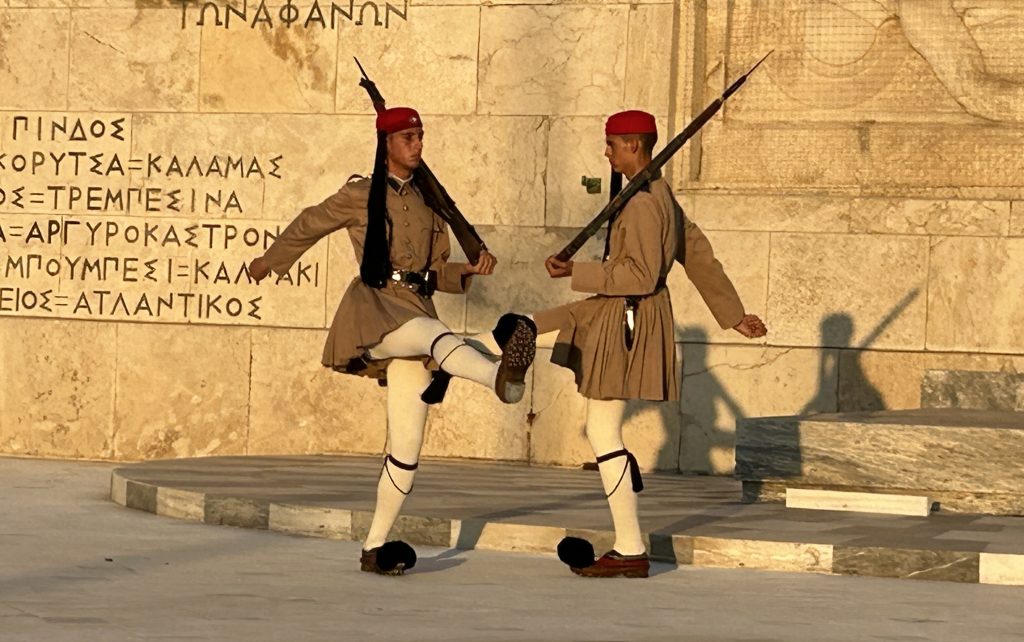
Changing of the Guard
Just before the top of the hour, the crowd parted and a contingent of fresh guards marched in. The light had faded and we witnessed the solemn ceremony in awe. At times, I felt moved to tears as I watched the men execute their incredibly slow movements in perfect synchronicity.
Dance Performance
If you’re visiting Athens during the summer, check out the folk dancing show at the Dora Stratou Theatre (#10). This 860-seat garden theater is located on Philopappou Hill, opposite the Acropolis.
Getting there is half the fun! From the Plaka district, you enter the dimly lit (and eerily empty when we visited) pathways that wind through the park surrounding the hill to the theatre. Just when you might start feeling a bit vulnerable with no theatre in site, you’ll arrive at the theatre. On a September evening a few days short of the end of the season, the large outdoor theatre was surprisingly empty.
What a shame! The show is well worth seeing. But be warned. If you visit in spring or in mid-September, like we did, take along a sweater. Since the daytime temperature had hovered around 28 degrees, I’d mistakenly believed that an outdoor concert in the evening would be balmy. Wrong! My light wrap was no match for the chill that began descending halfway through the performance.
What’s in the Show at the Dora Stratou Theatre?
A company of 75 dancers, musicians and folk singers clad in costumes from the theatre’s extensive collection performed for over an hour. The dances come from all over Greece, and are characterized by slow, steady movement interspersed with some fancy moves, mostly by the men.
Dinner in the Plaka
After the performance, stroll back to the Plaka district to enjoy a late dinner. Along the way, you’ll admire floodlit views of the Acropolis. This inspiring vista does not get old. Every time I glance up, I want to pinch myself.
I’m in Athens! This is so cool.
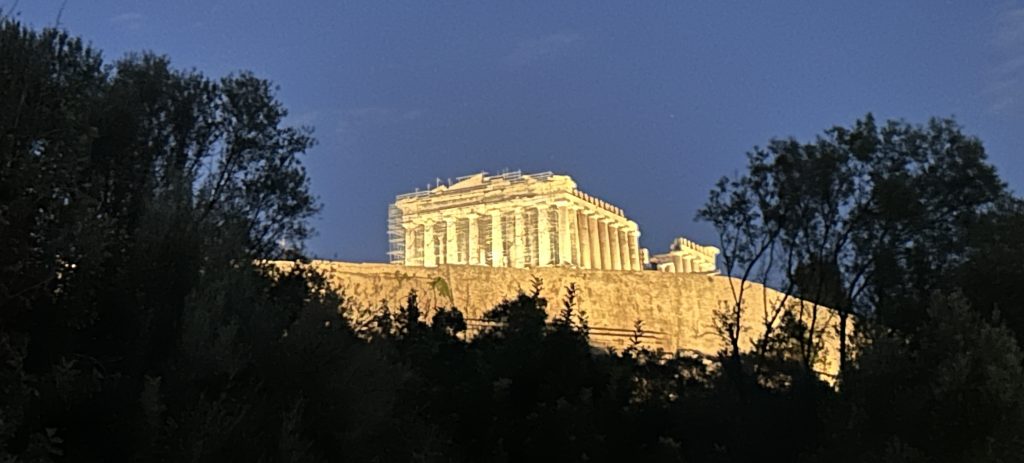
You’ll find plenty of places to eat in the Plaka district which admittedly is a little on the touristy side. But the atmosphere is lively, the food hearty, and the service friendly.
Relaxing at an outside table, dipping pita into fresh tzatziki and chatting about a full Artsy Traveler day in Athens is my kind of travel!
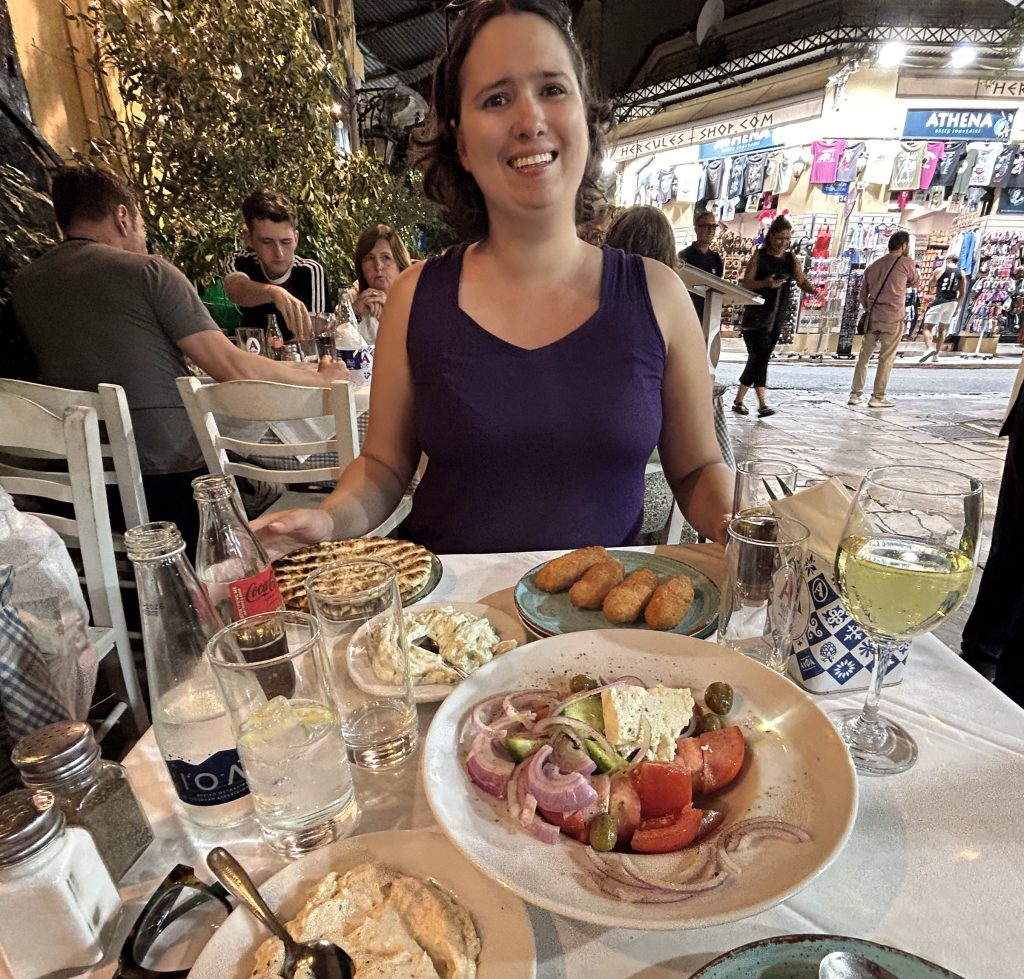
Shopping!
And after dinner? Well, the shops in the Plaka district stay open late, so why not end your day by shopping for souvenirs?
While many of the shops sell pretty schlocky stuff, such Kiss Me, I’m Greek T-shirts, persevere and you’ll find some gems. I found a lovely shop selling textiles and stocked up on placemats, a pillow cover, and tea towels, and Julia snagged a set of ceramic olive oil dispensers.
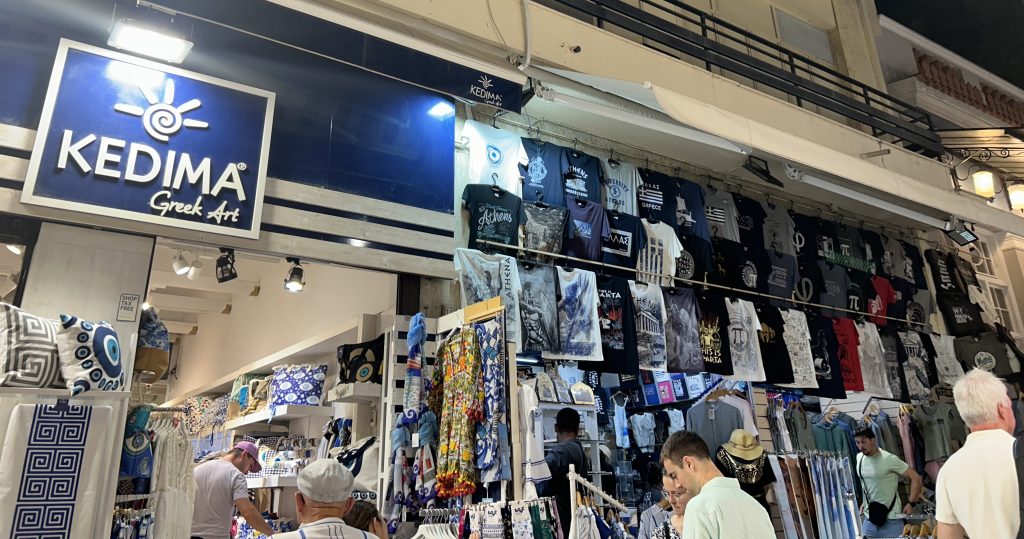
Where to Stay in Athens
On our recent trip to Athens, we stayed in two places: a holiday apartment for two nights and a hotel for one night. I highly recommend both, which are in neighborhoods convenient for sightseeing in Athens.
Karma Apartments
Steps from the lively Plaka district but on a quiet side street, Karma Apartments is a real find in Athens. The one-bedroom apartment we were assigned is on the top floor of a building containing other holiday lets, and even includes a large terrace with a peekaboo view of the Acropolis.
Hotel Lozenge
On our last night in Greece, we stayed at the Hotel Lozenge in the upscale Kolonaki neighborhood. This is a great choice for a business-style hotel with comfortable rooms, an attached restaurant, and very helpful staff.
Tours of Athens
Here are some tours of Athens from GetYourGuide.
Conclusion
You can definitely “do” Athens in one full day, although two days is better. Don’t just rush up to the Acropolis and call it a day. Explore some of the neighborhoods—Plaka, Syntagma, the Acropolis area, Monastiraki, Thissio (where the Agora is located), and elegant Kolonaki.
Slow down and enjoy this incredibly historical city. After all, Socrates walked here, and Plato too. Give them their due by walking slowly and breathing the same air they did (more or less). Maybe you’ll be struck by some deep philosophical thoughts that change the course of western civilization.
Here are more posts about travels in Greece:
- Stay in Oia for a Stunning Santorini Experience
- How to Spend Two Laid-Back, Glorious Days on the Greek Island of Naxos
- Nine Great Reasons To Visit Meteora in Greece
- Explore Greek Cuisine in a Savor Nafplio Cooking Class
- How To Spend Two Wonderful Days in Charming Nafplio in Greece
- Should You Make the Climb to the Acropolis of Athens?
Have you visited Athens? Share your comments and recommendations in the Comments below.
